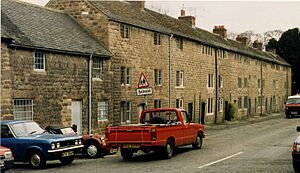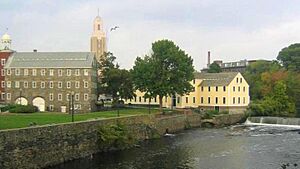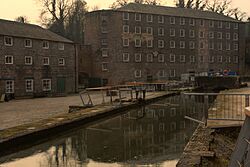Derwent Valley Mills facts for kids
| UNESCO World Heritage Site | |
|---|---|
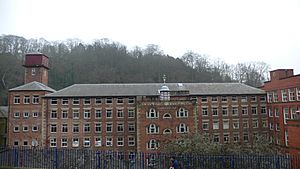
Masson Mills, Derwent Valley
|
|
| Location | Derbyshire, England |
| Criteria | Cultural: ii, iv |
| Inscription | 2001 (25th Session) |
| Area | 1,228.7 ha |
| Buffer zone | 4,362.7002 ha |
The Derwent Valley Mills is a special place in Derbyshire, England. It's a World Heritage Site, which means it's important to the whole world! This area along the River Derwent is where the modern factory system began in the 1700s.
Imagine a time when almost everything was made by hand. Then, a clever inventor named Richard Arkwright came along. He created new machines for spinning cotton. These machines used water power and could make cotton much faster. This led to the first factories, or 'mills', where many people worked together.
Arkwright's ideas changed how things were made. His system of using machines and organizing workers spread quickly. By 1788, there were over 200 mills like his in Britain. His inventions even went to Europe and the United States!
Before Arkwright, John Lombe first used water power for silk making in Derby in 1719. But Arkwright made it work for cotton in the 1770s. His special machine, called a water frame, could spin cotton all the time. This meant that even workers without special skills could help make cotton.
Arkwright built his first mill at Cromford Mill. He also built houses for his workers in the nearby village of Cromford. This idea of building homes and communities around factories was new. Other mill owners copied this plan. They built new towns with schools, churches, and markets for their workers. Many of these old houses are still used today!
Other mill owners, like Arkwright's rivals, also built mills and worker homes. You can find these at Belper, Darley Abbey, and Milford. Some people even copied Arkwright's machines without paying him!
Later, in the early 1800s, the cotton industry in the Derwent Valley slowed down. This was because other places, like Lancashire, were better for getting raw materials and selling products. But the old mills and buildings were kept safe. Many are now listed buildings, meaning they are historically important. Some mills are even museums you can visit!
Today, the Derwent Valley Trust is making a cycle-way along the whole site. This helps people explore the area and enjoy its history in a green way.
Contents
Where are the Derwent Valley Mills?
The Derwent Valley Mills World Heritage Site is a long area. It stretches for about 24 kilometers (15 miles) along the Derwent Valley in Derbyshire. It goes from Matlock Bath in the north to Derby city centre in the south.
This special site covers about 12.3 square kilometers (4.7 square miles). Inside, you'll find old mill buildings, villages where workers lived, and even weirs (small dams) on the River Derwent. The old transport networks, like canals, are also part of it.
The site includes the towns of Cromford, Belper, Milford, and Darley Abbey. There are 838 listed buildings here. These include mills, worker houses, and other buildings from the mill communities. The Cromford Canal and the Cromford and High Peak Railway are also important parts of this historic area.
A Look Back: The Story of the Mills
In the late 1600s, making silk became popular. People wanted more silk for fancy clothes. To make more, Thomas Cotchett asked an engineer, George Sorocold, to build a mill in Derby. This mill would use water power from the River Derwent. It didn't work out perfectly, but it gave John Lombe an idea.
Lombe, who worked for Cotchett, believed water power could be amazing. He secretly got plans for Italian machines. In 1719, he got a patent for his design. He then built a five-story silk mill next to Cotchett's. Lombe showed how water-powered machines could work and how to organize workers.
Silk was a luxury, so not many mills were built. But the next big step was in cotton. Cotton goods were cheaper and more people wanted them. Spinning cotton was harder than silk. Richard Arkwright invented the water frame for cotton in 1769. These machines could spin yarn all the time. They made it possible for less skilled workers to make cotton.
Water frames came in different sizes, from small to very large. They became very popular. In 1771, Arkwright rented land in Cromford. His first mill was running by 1774. He built a second mill in 1776. He also invented machines for preparing cotton before spinning.
Arkwright needed money to build his mills. Peter Nightingale, a local landowner, helped him. Nightingale bought the Cromford Estate and built a house for Arkwright. He also gave money for the second mill and for worker housing.
Between 1777 and 1783, Arkwright and his family built more mills. These were in places like Bakewell and Wirksworth. Jedediah Strutt, Arkwright's partner, built mills at Belper and Milford. Thomas Evans built a cotton mill in Darley Abbey in 1782. Many people copied Arkwright's machines, sometimes without permission!
Arkwright started building Masson Mill in Matlock Bath in 1783. Jedediah Strutt also built more mills. Strutt didn't have to invent new machines because Arkwright had already done the hard work. Strutt built a mill in Belper, and then a second one in 1784. He also built a mill in Milford. By 1793, he added more mills for printing and bleaching cotton.
Arkwright was known for caring about his workers. He built a Sunday School in Cromford in 1785. It taught 200 children. He also created a market place in Cromford to help the village grow. He even gave prizes to people who came to the market often.
After Arkwright died in 1792, his son, Richard Arkwright junior, took over. He sold most of the cotton mills outside Cromford. The family kept the mills in Cromford to support their home, Willersley Castle. Arkwright junior also built Cromford Church in 1797. The village of Cromford grew until about 1840, even as the mills started to slow down.
Richard Arkwright junior wasn't as interested in the cotton business as his father. But the Strutt family kept investing in their mills. They built more mills into the 1810s. By 1833, their business employed 2,000 people and was very important in the Derwent Valley.
Like Arkwright, the Strutts built houses for their workers. Belper was already a village with a market, so the Strutts didn't have to build as much from scratch. They also provided education. In 1817, many children went to Sunday Schools in Belper and Milford. Belper's population grew a lot because of the successful mills. Darley Abbey also grew, with many new worker houses. A Sunday School, church, and school were built there too.
Even though the Strutts were big in the cotton industry, they started to lose to mills in Lancashire. Lancashire was closer to raw materials and new markets. The Strutts' mills also didn't update their machines enough. They kept using child labor even when bigger machines needed adults. The company declined, and some mills were sold off.
However, many of the old mill buildings and worker houses in the Derwent Valley are still here. There are 848 listed buildings in the World Heritage Site today.
Getting Around: Canals and Railways
To move goods and materials, the mills needed good transport. Canals and railways were built to help.
The Cromford Canal: A Water Highway
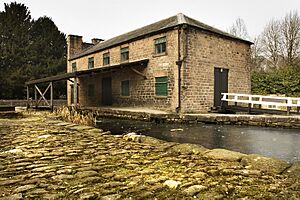
The Erewash Canal was started in 1777 to move coal. It went from the River Trent to Langley Mill. In 1788, Richard Arkwright asked William Jessop to see how much it would cost to connect his mills at Cromford to Langley Mill with a canal. It was estimated to cost £42,000, and the money was raised quickly.
Some local mill owners, like Jedediah Strutt, didn't like the idea. They worried it would take water from their mills. But in 1789, Parliament said yes to building the canal.
The Cromford Canal opened in 1794. It cost almost twice the original estimate! It had two aqueducts (bridges for water), a long tunnel, and fourteen locks to help boats go up and down hills. Most of the cargo was coal, but also stone, iron, and lead.
Later, other canals connected the Cromford Canal to important cities like Derby and Nottingham. The canal was very successful until the mid-1800s. Then, a railway line was built nearby, which made the canal less important. In 1852, the railway company bought the canal. It slowly declined and closed in 1944 because it was too expensive to fix. Today, the Cromford Canal Society is working to restore it.
The Cromford and High Peak Railway: Iron Horses
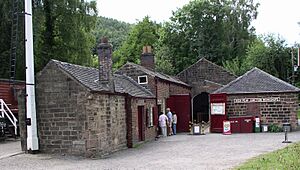
In the early 1800s, people wanted to connect the Peak Forest Canal with the Cromford Canal. This would create a direct route between markets in Lancashire and Derbyshire. But a canal would be too expensive. Josias Jessop, William Jessop's son, thought a railway would be much cheaper.
On May 2, 1825, a law was passed to build a railway from Cromford to Whaley Bridge. Important people like William Cavendish, 6th Duke of Devonshire and Richard Arkwright junior supported it. They even hoped to use steam locomotives, which were very new at the time!
The southern part of the railway opened on May 29, 1830. The rest of the line opened in 1831. The first steam locomotive arrived in 1841. Before that, wagons were pulled by other means.
The railway went up and down big hills. It climbed from 277 feet (84 meters) above sea level at Cromford to 1,264 feet (385 meters) at Ladmanlow. This would have needed many locks for a canal, but it was easier for a railway. For a while, this railway had the sharpest curve and steepest incline in Britain!
The railway cost £180,000 to build. This was more than planned, but much less than a canal would have cost. The railway's success depended on the canals it connected. But by the time it opened, traffic on the Cromford Canal was already slowing down.
In 1855, the railway was allowed to carry passengers too. Even though passenger travel became more important, the railway declined and closed on April 21, 1967.
Why the Mills are Important Today
The Derwent Valley is known as the birthplace of the factory system. The machines invented here, like the water frame, allowed things to be made continuously. Richard Arkwright's Cromford Mill and its worker village became a model for industrial communities everywhere.
He built houses for workers because he needed people to run his machines. The only way to get enough workers was to give them homes for their families. Other factory owners copied Arkwright's successful idea. People like Peter Nightingale, Jedediah Strutt, and Thomas Evans built towns for their employees in the Derwent Valley. They cared for their workers, which is called paternalism.
Arkwright also invented many technologies for water-powered spinning. His inventions were so good that other factory owners risked trouble by copying them. After his patents (rights to his inventions) ran out in 1785, over 200 mills like his were built in Britain.
Other famous World Heritage Sites, like New Lanark in Scotland and Saltaire, were directly influenced by the Derwent Valley. They used Arkwright's ideas for mills and worker housing.
In 1774, the British government tried to stop new machine plans from leaving the country. But people still found ways to share the ideas. Carl Delius worked in England and gave plans for Arkwright's machines to Johann Gottfried Brugelmann. Brugelmann used these plans to build the first Arkwright mill in mainland Europe, in Germany, in 1784. He even named the worker village Cromford!
The cotton spinning techniques also went to America. In 1790, America had very few machine spindles compared to Britain. Samuel Slater, who was from the Derwent Valley and learned from Jedediah Strutt, brought the Arkwright mill idea to America. He founded Slater Mill in Rhode Island.
Many of the technologies from the Derwent Valley Mills lasted a long time. Even in the mid-1900s, some machines for preparing cotton were still based on Arkwright's inventions. The factory system made it possible to produce cheap clothes and textiles for everyone.
Keeping History Alive: Preserving the Mills
In 1971, a group called The Arkwright Society was formed. They bought the Cromford Mill complex in 1979. This saved the buildings from being torn down. The society wanted to protect and restore the mills.
The mills had been used by a dyes and paints company after cotton production stopped. This left them with harmful chemicals. With help from many groups and a lot of money (about £5 million), the mills were cleaned and restored. Now, Cromford Mill is used by small businesses and for education.
Many of the mills built in the Derwent Valley are still standing. They were used for other things after the cotton industry declined. Most of the worker houses are also still there and people live in them. In the 1970s and 1980s, local groups helped owners fix up these historic homes and mills.
In 2000, the Derwent Valley Mills were nominated to become a World Heritage Site. This was to highlight important industrial history. The nomination was successful, and in 2001, the Derwent Valley Mills became a World Heritage Site. This special status helps make sure the site is protected because it's considered "outstanding value to humanity."
The Derwent Valley Mills were important for creating worker housing and new technologies. They shaped industrial towns. The Derwent Valley Mills Partnership helps manage the site for the British government. In 2009, Bath Street Mill in Derby, an 18th-century building in the site, was damaged by fire.
In 2018, a project at Cromford Mills was a finalist for an award for restoring historic places. By 2019, the Arkwright Society had spent £48 million on restoration and employed 100 people at Cromford Mills.
Explore the Mills: Museums to Visit
- Richard Arkwright's Masson Mill is now a working textile museum. It has the world's largest collection of bobbins (spools for thread).
- Leawood Pumphouse is a working museum. It still pumps water from the Derwent to the Cromford Canal on certain weekends.
- At Belper, the Belper North Mill building houses the Derwent Valley Visitor Centre. Here you can see old machines and learn about the textile industry.
- At the very south end of the site, Lombe's Silk Mill is now the Museum of Making.
- The Museum of Making opened in November 2021. It has exhibits about the history of the Derwent Valley Mills and how things are made.
See also
 In Spanish: Fábricas del valle del Derwent para niños
In Spanish: Fábricas del valle del Derwent para niños




